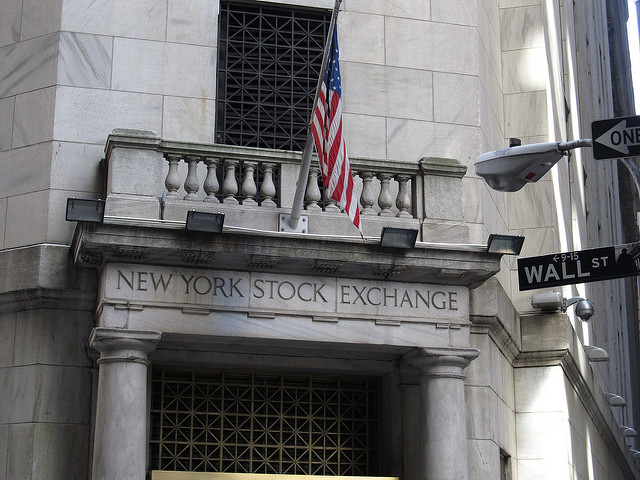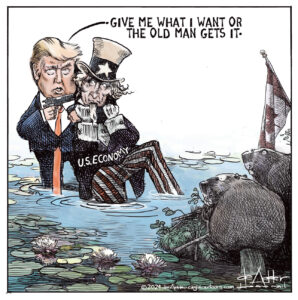Jittery Wall Street Has a Lot to Be Nervous About
Investors have been careening from fear to relief and back again as they react to news about trade talks and the health of the economy. Ken Lund / Flickr
Ken Lund / Flickr
NEW YORK — Welcome to the brave new world of investing, where every day in the stock market can feel like bedlam.
Investors have been careening from fear to relief and back again as they react to morsels of news about the health of the economy and corporate profits, the global trade war and when the Federal Reserve will next raise interest rates.
With each mood shift, stock prices have swung wildly. Unusually big moves — both up and down — have come at a frequency not seen in years.
On Friday, the S&P 500 index soared 3.4 percent following a stronger-than-expected U.S. jobs report, news of trade talks between the United States and China and comments from the Fed seen as helpful for stocks.
It was a sharp reversal from just the day before when investors saw the glass decidedly half empty. On Thursday, the S&P 500 plunged 2.5 percent after a disappointing U.S. manufacturing report raised fears about a possible recession and Apple warned about weak iPhone sales in China. That two-day whiplash followed 2018, a year when the S&P 500 had 20 days where it swung by at least 2 percent, twice as many as any of the prior six years.
The market has gotten so topsy-turvy that when Friday’s jobs report first came out, about an hour before the New York Stock Exchange opened, some investors wondered if it would cause relief or panic. The numbers were strong, but were they so strong as to push the Fed to raise rates faster, which would be bad for stocks?
“I did find myself wondering how the market is going to react to this: Are people asking, ‘Is this good?’” said Ernie Cecilia, chief investment officer at Bryn Mawr Trust. “It just shows the environment we’re in. It’s uncertain how the market reacts, or overreacts.”
Expect the jitters to continue. Reports are coming that will give investors clues about whether their fears of a possible recession are warranted, as well as updates on interest rates and trade policy. Among the approaching milestones that could be the next to roil Wall Street:
— Earnings season
Starting next week, companies will begin reporting their profits for the last three months of 2018, and expectations are high. Analysts are forecasting 11.4 percent growth for S&P 500 companies, which would be the fifth straight quarter of gains topping 10 percent, according to FactSet.
Those numbers are key because stock prices tend to track corporate profits over the long term. But even more attention will likely be paid to what CEOs say about future profits.
“We’re going to have a nice, solid double-digit number” for fourth-quarter earnings growth, said Phil Orlando, chief equity market strategist at Federated Investors. “I think the market’s bigger concern is how big the 2019 deceleration is.”
Executives generally talk with analysts and investors immediately after their companies’ quarterly earnings are released. Stock prices could swing depending on what they say about how moderating economic growth, U.S.-China trade tensions and interest rates could affect their upcoming results.
Apple’s warning last week about slow iPhone sales in China, the world’s second-largest economy, shocked the market and sent Apple’s stock down nearly 10 percent. On the same day, Delta Air Lines fell nearly 9 percent after it trimmed its forecast for fourth-quarter revenue.
Orlando said he expects earnings growth will remain positive in 2019, just slower than last year, much like the economy. He nevertheless expects stocks to claw back their recent losses and return to a record by the end of the year, though with a lot of volatility in between.
— U.S.-China trade talks
A U.S. delegation began talks in Beijing on Monday aimed at resolving a trade dispute that has alarmed global investors and threatens to drag down worldwide economic growth.
The world’s two biggest economies are battling over U.S. allegations that Beijing uses predatory tactics to acquire advanced technologies, potentially undermining American technological dominance. According to a March report by the U.S. trade representative, China hacks into American companies’ computer networks to steal trade secrets and forces foreign firms to share technology as the price of admission to the Chinese market.
The standoff will be difficult to resolve before a March 1 deadline. That is when U.S. tariffs on $200 billion in Chinese imports are scheduled to jump to 25 percent from 10 percent. Chinese leaders have signaled their willingness to address U.S. complaints about America’s massive trade deficit with China by buying more soybeans, natural gas and other U.S. products.
But they are likely to resist pressure from Washington to scrap or scale back technology policies they see as vital to China’s future prosperity and strength.
— Federal Reserve meeting
The next Fed meeting comes in the last week of January, but most economists don’t expect much action from it. The central bank is likely to leave rates alone after raising them four times last year.
Investors instead will be more interested to hear what Fed Chairman Jerome Powell says in his news conference following the meeting. Markets have parsed every word Powell has said in public, hoping to divine clues about the path of interest rates. Higher interest rates can forestall inflation, but they can also slow economic growth and drive buyers away from stocks.
After Powell’s news conference in December, for example, the S&P 500 slumped 1.5 percent on worries that the Fed seemed set on raising short-term rates three times into 2020 and letting its portfolio of bond purchases shrink on “automatic pilot.”
“The Street is looking for some definitive evidence that this (Fed) board of governors gets it, and that three more rate hikes and (an inflexible approach to) balance-sheet shrinkage is too aggressive,” Orlando said.
Investors heard some of that Thursday when Powell said the Fed will be patient in raising rates and flexible about unwinding the balance sheet. Starting this month, the Fed chairman will hold a news conference following each Fed meeting, so investors will have plenty more opportunities to parse Powell’s words.
Your support is crucial...As we navigate an uncertain 2025, with a new administration questioning press freedoms, the risks are clear: our ability to report freely is under threat.
Your tax-deductible donation enables us to dig deeper, delivering fearless investigative reporting and analysis that exposes the reality beneath the headlines — without compromise.
Now is the time to take action. Stand with our courageous journalists. Donate today to protect a free press, uphold democracy and uncover the stories that need to be told.






You need to be a supporter to comment.
There are currently no responses to this article.
Be the first to respond.